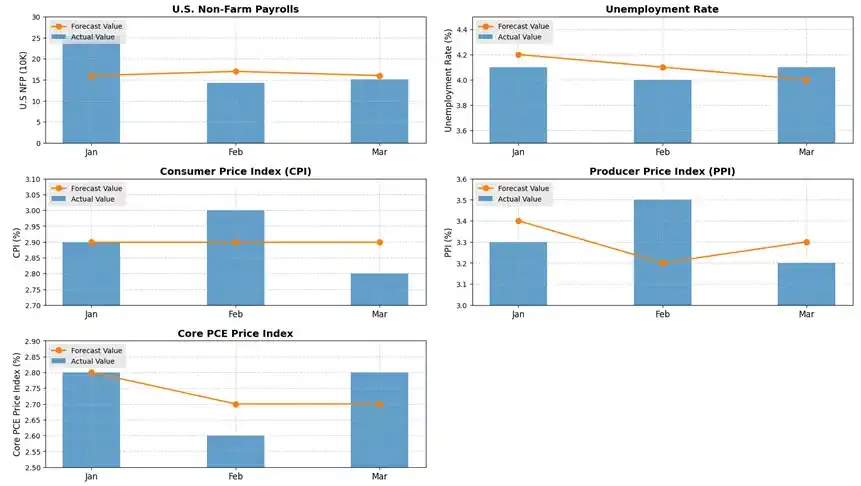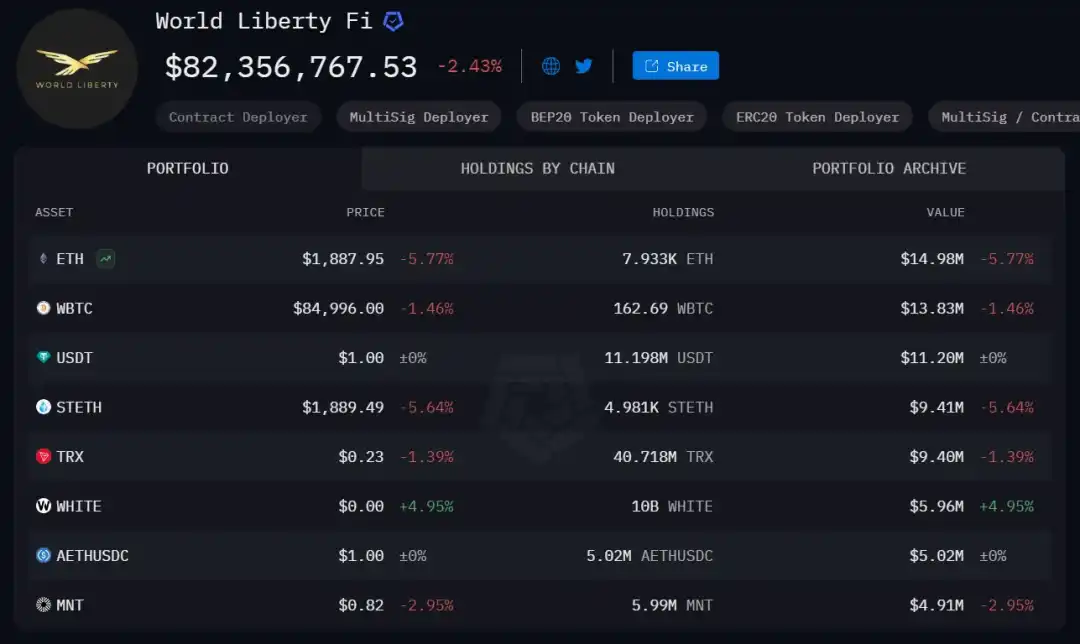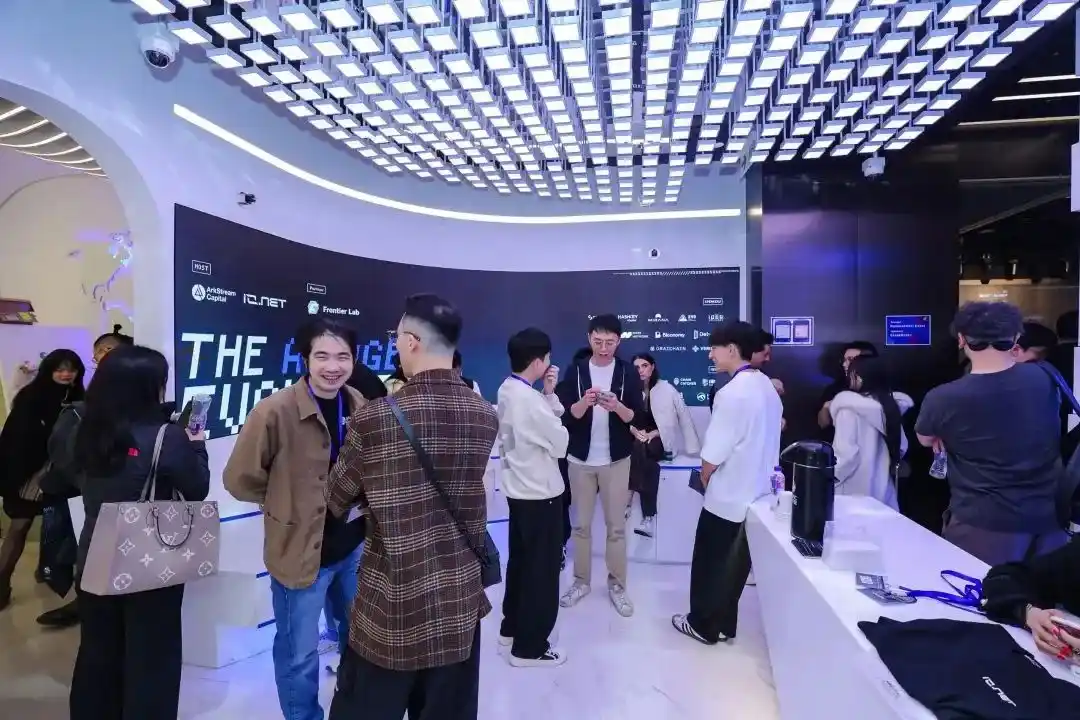Original Title: "ArkStream Capital: The Power Game of WLFI and the Integration of CEX-DEX"
Original Source: ArkStream Capital

Industry Overview
At the beginning of 2025, the cryptocurrency market opened amidst a complex mix of optimism and uncertainty. The industry had multiple expectations for the new year: the potential benefits of a shift in the Federal Reserve's monetary policy, a second explosion of the AI technology revolution, and the new U.S. government's commitment to a "crypto-friendly" regulatory framework were all seen as catalysts for breakthroughs in the industry. However, as the dust settled in the first quarter, the market presented a stark picture of "strong macro narrative turbulence, deep micro innovation dormancy."
The global macroeconomic environment became the core variable dominating market rhythm, with the Federal Reserve struggling to balance between recurring inflation and recession risks. The unexpected hype around recession rate cut expectations in March briefly boosted risk appetite but failed to offset the liquidity panic triggered by the bursting of the U.S. stock market valuation bubble. Meanwhile, the Trump administration fulfilled its campaign promises, promoting Bitcoin as a national strategic reserve and digital asset strategic reserve, as well as implementing the "Digital Asset Regulatory Clarity Act," releasing structural benefits for the industry. However, the parallel of policy dividends and the SEC's lenient enforcement also intensified market debates over the "cost of compliance transformation."
After Bitcoin broke through the historical high of $100,000 in January, it encountered a 30% deep correction, exposing the market's capital to phase-based profit-taking on the "halving narrative." The overall performance of the altcoin market was lackluster, but the birth and delivery of products such as RWA and user entry points, which brought in capital and user increments, still injected underlying innovative momentum into the industry. Notably, CEXs like Binance accelerated their layout of the DEX ecosystem, promoting seamless user access to DeFi and other dApp scenarios through on-chain liquidity aggregation and account abstraction technology, and for the first time allowed CEX users to trade DEX assets directly within their accounts. This paradigm shift of "integration of centralization and decentralization" may become a key pivot for growth and breakthroughs in the next cycle.
Macroeconomic Environment and Impact
In the first quarter of 2025, the U.S. macroeconomic environment had a profound and complex impact on the cryptocurrency market. For the cryptocurrency market, starting with ETFs through BTC spot, the positive correlation between the entire crypto market and U.S. stocks has increasingly strengthened, with the Nasdaq's performance to some extent directly determining the direction of the cryptocurrency market. Although BTC was dubbed "digital gold" in earlier years, cryptocurrencies are currently more inclined towards risk assets rather than safe-haven assets, being more affected by market liquidity. ArkStream will continue to monitor changes in macroeconomic trends in the future.
The core of the macroeconomy lies in the balance between inflation and economic strength. The market trades on expectations for the future: if inflation is too high or the economy is too strong, the Federal Reserve will tend to delay rate cuts, which is unfavorable for the capital market; conversely, if the economy performs too weakly, it may trigger recession risks, which is also detrimental to market confidence and capital flow. Therefore, the macroeconomy needs to find a subtle balance between strength and weakness to provide a favorable environment for the capital market. The DOGE sector's large-scale layoffs of government agency staff directly caused an increase in the unemployment rate. Meanwhile, Trump's tariff policy exacerbated inflationary pressures by directly raising the prices of affected goods and the costs of related service industries, increasing the likelihood of a recession in the U.S. economy.
This series of policies has increased market instability, leading to greater volatility in the capital market. Considering the high gains brought by the election market in Q4 2024 and the potential for significant market fluctuations in the short term, ArkStream Capital has scaled back its investment plans in Q1 2025, focusing more time and energy on exploring OTC strategies and channel expansion.
However, considering that such policies may not merely be economic control measures but rather a means for the Trump administration to increase its bargaining chips in political negotiations with other countries, or to deliberately create chaos to achieve specific political and economic goals—namely, to force the Federal Reserve to quickly implement emergency defensive rate cuts by creating signs of economic recession, thereby achieving a win-win in alleviating the U.S. national debt issue and stimulating economic growth and capital market performance—we remain optimistic about the subsequent performance of the cryptocurrency market.
In the first quarter, the cryptocurrency market's response to macroeconomic data demonstrated a high degree of sensitivity. Below is a month-by-month analysis of market performance in January, February, and March.

In January, U.S. macroeconomic data was overall strong, but the market's reaction was relatively stable. On January 10, the seasonally adjusted non-farm payroll data for December was released, with an expected value of 160,000 and an actual value of 256,000, significantly exceeding market predictions; the unemployment rate for December, released on the same day, was 4.1%, lower than the expected 4.2%, further confirming the strong economic performance. On January 14, the December PPI year-on-year rate was announced at 3.3%, slightly below the expected 3.4%, seen as a signal of short-term alleviation of inflationary pressures.
However, the December unadjusted CPI year-on-year rate released on January 15 was 2.9%, in line with expectations but up 0.2% from the previous month, beginning to raise market concerns about rising inflation and delayed rate cuts. On January 31, the December core PCE data was 2.8%, in line with expectations, and did not significantly disturb market expectations. Overall, the data in January did not cause significant fluctuations in the cryptocurrency market, with the strong employment market and stable inflation data keeping the prices of assets like BTC relatively stable.
Entering February, the cryptocurrency market experienced sharp fluctuations due to deviations between macroeconomic data and expectations. On February 7, the seasonally adjusted non-farm payroll data for January was released at 143,000, below the expected 170,000; the unemployment rate for January, released on the same day, was 4.0%, lower than the expected 4.1%, indicating unclear performance in the employment market and exacerbating market uncertainty in the short term. On February 12, the unadjusted CPI year-on-year rate for January was announced at 3.0%, higher than the expected 2.9%, with inflation continuing to rise and exceeding expectations, leading to a collapse in market confidence regarding rate cuts. Traders generally bet that rate cuts might only occur once in December this year, which had a huge negative impact on market sentiment, with BTC dropping 2,500 points, a decline of 2.66%, within 15 minutes of the data release.
The next day, the January PPI year-on-year rate was released at 3.5%, higher than the expected 3.2%, further intensifying market concerns about lowered rate cut expectations. This was seen as a trigger for weakened buying power, and in the following half month, BTC fell by about 20%, with a decline of 20,000 points. It wasn't until February 28, when the January core PCE price index was announced at 2.6%, below expectations, that the market stabilized and formed a bottom. Notably, the weak performance of the financial and medical services sectors in the PPI data had already provided a preliminary signal for the PCE's decline.
In March, the overall improvement in macroeconomic data led to a slight warming of market sentiment, but the core PCE's better-than-expected performance again triggered volatility. On March 7, the seasonally adjusted non-farm payroll data for February was released at 151,000, slightly below the expected 160,000; the unemployment rate for February, released on the same day, was 4.1%, higher than the expected 4.0%, indicating slight weakness in the employment market. On March 12, the unadjusted CPI year-on-year rate for February was announced at 2.8%, below the expected 2.9%; on March 13, the February PPI year-on-year rate was announced at 3.2%, slightly below the expected 3.3%.
This series of data indicates that the economy is operating on a solid foundation, with inflationary pressures easing and the rate cut process expected to accelerate. As a result, the cryptocurrency market experienced a brief rebound in the following 10 days. However, on March 28, the February PCE price index year-on-year rate was announced at 2.5%, in line with expectations, but the core PCE year-on-year rate was 2.8%, higher than the expected 2.7%. In the 10 hours prior to the data release, the market experienced a significant drop due to concerns over the core PCE exceeding expectations, demonstrating ongoing sensitivity to inflation data.
In summary, in the first quarter of 2025, U.S. macroeconomic data had a significant and variable impact on the cryptocurrency market. January saw strong economic performance but a muted market reaction; February's inflation exceeding expectations led to a sharp drop in rate cut expectations and a significant decline in BTC; March's improvement in economic data spurred a brief rebound, but the core PCE exceeding expectations again triggered a pullback. Trump's tariff policy, by exacerbating inflationary pressures, increased market uncertainty and may become an important factor in forcing the Federal Reserve to adjust its policies. Looking ahead, the trajectory of the cryptocurrency market will still heavily depend on macroeconomic data and the Federal Reserve's policy direction, and investors need to closely monitor the dynamics of inflation and employment data to accurately grasp market trends.
Trump Administration's Cryptocurrency Policy and Impact
In March 2025, Trump signed an executive order requiring the establishment of a strategic Bitcoin reserve, primarily funded by approximately 200,000 Bitcoins (valued at about $18 billion) seized from criminal or civil forfeitures, and prohibited the government from selling Bitcoins in the reserve. This move aims to elevate Bitcoin as a "sovereign reserve asset," enhancing its legitimacy and liquidity while promoting the U.S.'s leadership in the digital asset space. Although Bitcoin's price surged over 8% in the short term, boosting market confidence, the market soon believed that the reserve relied solely on forfeited assets without any new purchase plans, leading to a rapid price decline.
In the long run, this move may prompt other countries to follow suit, pushing Bitcoin to become an international reserve asset. Additionally, a series of non-Bitcoin digital assets may also be included in the digital asset reserve. This would signify a transformation of cryptocurrencies from marginalized assets to national strategic tools. Although the market's short-term reaction was hindered, its long-term impact could reshape the global financial system: on one hand, promoting Bitcoin to become a mainstream reserve asset, and on the other hand, intensifying competition among sovereign nations in the digital finance sector.
In terms of regulation, after taking office, Trump pushed for the dismissal of SEC Chairman Gary Gensler and established a cryptocurrency asset working group to clarify the classification standards between securities and non-securities tokens, terminating lawsuits against companies like Coinbase. Furthermore, the controversial accounting standard SAB 121 was abolished, reducing the financial burden on companies. The regulatory environment has significantly loosened, accelerating the entry of institutional investors; traditional financial institutions like banks have been authorized to conduct cryptocurrency custody services, promoting the industry's compliance process. This series of regulatory policies has changed the ecology of the U.S. cryptocurrency and financial industry through deregulation, restructuring frameworks, and promoting legislation. In the short term, policy dividends may accelerate technological innovation and capital inflow; however, in the long term, one must be wary of systemic risks and the complexities of global regulatory competition. In the future, the effectiveness of policy implementation will depend on multiple variables, including judicial challenges, economic cycles, and political maneuvering.
In terms of stablecoin development, the Trump administration established a federal regulatory framework for stablecoins, allowing stablecoin issuers to access the Federal Reserve's payment system, and explicitly prohibiting the Federal Reserve from issuing central bank digital currency (CBDC) to maintain the innovative space for private cryptocurrencies. The application of stablecoins in cross-border payments accelerated, expanding the path for the internationalization of the dollar; the market share of private stablecoins increased, deepening integration with the traditional financial system.
Regarding tariff policy, in February 2025, Trump signed the "Reciprocal Trade and Tariff Memorandum," requiring U.S. trading partners to align their tariff rates with those of the U.S. and imposing tariffs on countries implementing value-added tax systems. This memorandum serves as a framework document for the adjustment of U.S. trade policy, aimed at reducing the U.S. trade deficit and addressing issues of trade inequality and imbalance. Subsequently, Canada, Mexico, the European Union, and others quickly took countermeasures, leading to a spiral increase in global tariff barriers for the first time. On April 2, 2025, Trump signed an executive order on reciprocal tariffs, further refining and implementing the policy direction outlined in the February memorandum. This order aims to reduce the U.S. trade deficit, promote the return of manufacturing, and protect the U.S. economy and national security by imposing higher reciprocal tariffs on countries with the largest trade deficits with the U.S. This move triggered rapid countermeasures from the most affected countries, particularly China, which took corresponding countermeasures immediately, leading to a formal stage of serious divergence and friction in economic and trade relations between the two sides.
Under the influence of such tariff policies, global trade costs are bound to increase, and the scale of international trade may shrink. Production costs have risen significantly, supply chains are being restructured at an accelerated pace, and corporate investment willingness has declined. Most critically, the U.S. will have to face the pressure of imported inflation. The Federal Reserve's monetary policy is caught in a dilemma, with expectations for rate cuts being postponed. The tariff policy also forces companies to shift production to Latin American countries like Mexico, but issues of infrastructure and labor shortages in the U.S. hinder the return of manufacturing. Industries reliant on global supply chains, such as automotive and electronics, have been severely impacted, increasing profit pressures on multinational corporations, and leading to corrections in the stock prices of major U.S. tech giants.
Emerging markets face challenges in accommodating the transfer of industrial chains, making it difficult to fully fill the demand gap from the U.S. in the short term. The tariff war has also weakened trust in the dollar as an international trade settlement currency, resulting in a decline in the prices of ten-year Treasury bonds and a corresponding rise in yields. Behind this is also the Trump administration's plan to reduce debt expenditures and borrowing costs, prompting some countries to explore paths to de-dollarization. In the financial markets, global financial markets, including U.S. stocks, A-shares, and the Nikkei, have generally seen significant declines, with market liquidity facing immense pressure.
Trump's cryptocurrency policy, through regulatory loosening and strategic reserves, has temporarily boosted market confidence and attracted capital inflows, but in the long term, one must be wary of the risks of centralized computing power and policy reversals. While the tariff policy, under the banner of "America First," has led to the fragmentation of the global trade system, increased inflation, and heightened expectations of economic recession, it has forced capital to flow from risk assets to safe-haven assets like gold. These two major policies together highlight the contradictions and gamesmanship of the U.S. in the transformation of the digital economy and the real economy.
Since its launch in 2024, the DeFi project World Liberty Financial (WLFI), supported by the Trump family, has had a multidimensional impact on the cryptocurrency industry due to its political background and capital operations. WLFI is seen as a "barometer" of the Trump administration's crypto-friendly policies, with its asset allocation and strategic partnerships interpreted by the market as a "presidential selected portfolio," attracting investors to follow suit. In the short term, this may exacerbate the market's reliance on "political narratives," driving price fluctuations of specific tokens, while in the long term, one must be wary of the risks of policy reversals. At the same time, WLFI launched the USD1 stablecoin in March 2025, emphasizing compliance and institutional-grade custody. If it successfully penetrates cross-border payment and DeFi scenarios, it may weaken the market share of existing stablecoins while promoting the digitalization of the dollar and consolidating the U.S.'s dominant position in the global financial system.
Additionally, WLFI's operations benefit from the Trump administration's policy adjustments, providing a compliance template for similar projects, lowering the compliance threshold for the industry, and attracting traditional financial institutions to participate in crypto business, but it may lead to market bubbles due to regulatory arbitrage.
In terms of long-term strategic value, WLFI heavily invests in various cryptocurrencies, such as BTC, ETH, AAVE, ONDO, and ENA, thereby resonating with the "strategic crypto reserve" policy promoted by the Trump administration. This layout may guide more capital to focus on cryptocurrency assets, thereby promoting digital asset reserves to become the core narrative of the next cycle. At the same time, WLFI's operational model provides a reference case for other projects in "government-business interaction," and more crypto projects relying on political forces may emerge in the future, but it is necessary to balance compliance with decentralization principles.

In summary, WLFI's impact on the cryptocurrency industry has a double-edged sword effect. On one hand, it accelerates the compliance process through political empowerment, promotes the integration of DeFi and institutional capital, and explores the global application of the dollar stablecoin; on the other hand, reliance on policy dividends may lead to market bubbles, and opaque profit distribution may trigger a trust crisis, while poor project execution could become a negative case for the industry. In the future, it is essential to focus on the progress of WLFI's product implementation, the market acceptance of USD1, and the supporting role of the Trump administration's policy coherence.
Integration of CEX and DEX
Trading platforms and Web3 wallets serve as important entry points into the crypto world. Users often first use fiat currency on mainstream trading platforms to recharge assets and engage in cryptocurrency trading, lending, and wealth management, or interact with various dApps through Web3 wallets on different public chains. In the past, the boundaries between the two were clear. Due to the high threshold and educational costs of using Web3 wallets, ordinary users mostly began their Web3 journey through trading platforms, and centralized trading platforms retained users through services that were more mature and liquid than decentralized dApps. Especially entering 2025, trading platform businesses have become more mature compared to the previous cycle, with Binance announcing in 2024 that its user base reached 200 million, doubling from the previous cycle. In contrast, the number of native on-chain users in Web3, constrained by various factors, is only about 10% of that of centralized trading platforms.
Since 2023, trading platforms have entered the Web3 wallet product market, leveraging their accumulated asset management experience from trading platform wallets. Among them, OKX Wallet has attracted numerous users at the product level, successfully garnering a large user base with its excellent product experience in areas such as asset management, on-chain interaction, and trading optimization. CEXs utilize their advantages in the trading platform wallet module, such as building different public chain RPCs, to create more complete and superior wallet products, achieving user attraction and retention. However, OKX Wallet is essentially not significantly different from traditional Web3 wallets; it is merely a higher quality, more convenient multi-chain wallet that does not break the usage threshold of native Web3 wallets.
The Binance Web3 Wallet is closely tied to trading platform accounts, initially supporting rapid receiving and sending of assets between on-site assets and Web3 wallets, reducing users' security concerns when using Web3 wallets, and providing guarantees from the trading platform level. At the same time, Binance Web3 has launched multiple IDOs aimed at ordinary users within its ecosystem, attracting more on-site users to participate and learn on-chain knowledge. Additionally, its latest wallet feature allows on-site users to directly purchase Alpha series on-chain assets, achieving the functionality of purchasing on-chain assets directly from within the CEX, completely breaking the traditional boundaries between CEX and DEX.

Data Source: Dune, https://dune.com/lz_web3/wallet-war
Unlike mainstream CEX-dominated Web3 wallets, native crypto projects can focus on the actual and urgent needs of on-chain users in the wallet space. Particle Network, leveraging its years of experience in MPC and account abstraction technology, has seized the unified account demand arising from multi-chain trading and launched UniversalX. This product integrates wallets and trading platforms, effectively solving the challenges of transferring and trading assets across different chains, helping users achieve convenient management and efficient trading of assets in a multi-chain environment. With this innovative product, Particle Network has gained a good reputation and wide recognition in the market.

Data Source: Dune
The integration of CEX and DEX is not only a technological innovation but also a milestone in the cryptocurrency market's transition from "opposition and division" to "collaborative coexistence." This transformation, while enhancing efficiency and inclusivity, also gives rise to new challenges in regulation, security, and governance. In the future, whoever can better balance centralized efficiency with the security and autonomy of decentralized assets will be able to dominate the evolution direction of the next generation of financial infrastructure.
Project Investment

SOON
Project Introduction
Soon has restructured and launched its self-developed Solana virtual machine—Soon SVM—by removing the voting governance mechanism, enhancing dApp efficiency, integrating a data availability layer, and introducing a fraud proof mechanism, providing efficient and high-performance scaling solutions for mainstream blockchains like Bitcoin and Ethereum. On this basis, Soon launched InterSOON to support interoperability between different chains and integrated Jump's high-performance Solana client Firedance. Soon will launch its own SVM network SOON based on the SVM framework and deploy it on multiple public chains such as Bitcoin, Ethereum, TON, and BSC. Through InterSOON, it provides liquidity pools and interoperability functions internally, enabling seamless transfer of assets and data between different blockchains.
Why Invest in Soon
In the current thriving blockchain ecosystem, the pursuit of high performance remains one of the core driving forces behind technological innovation. Existing fraud-proof Rollup layer two solutions cleverly separate the execution layer from the data availability layer, allowing different components to perform their respective roles and laying a solid foundation for enhancing overall performance. With the increasing maturity of DA technologies such as EigenDA and Celestia, a high-performance execution layer becomes particularly crucial. Among the many projects exploring high-performance execution layers, Monad and MegaETH focus on the development of high-performance EVMs, while Movement achieves breakthroughs through MoveVM. For Solana, which carries a large volume of on-chain daily active users and transactions, its SVM is also an extremely successful execution layer choice.
However, the native SVM previously had some limitations, such as not supporting DA integration, relatively low efficiency, and incompatibility with fraud proofs, making it difficult to use directly as an execution layer. Soon accurately identified this pain point and successfully added fraud proof support to SVM through the development of Decoupled SVM, achieving efficient DA integration while optimizing Merkle technology, significantly enhancing security and scalability, and maintaining consistency with Ethereum's MPT (Merkle Patricia Trie). This reflects Soon's profound technical strength and positions it in the high-performance blockchain track, bringing new technological possibilities and application scenario expansions to the Solana ecosystem and the entire blockchain industry.
Looking back at the multi-cycle development history of blockchain, Solana has built a large and powerful ecosystem with its tenacious vitality. Abundant on-chain funds and numerous active users provide a solid foundation for Solana's continued development. As a key component of Solana, SVM is not only the core of its technical architecture but also a symbol of the Solana ecosystem.
Relying on SVM, the Soon project can provide expansion support for other public chains, activating more on-chain funds and attracting excellent Solana ecosystem projects to build. For developers, the high-performance SVM execution layer and mature DA integration solutions provided by Soon will significantly reduce development difficulty and improve development efficiency, allowing them to focus more on the development of innovative applications, further enriching the SVM ecosystem and promoting the advancement of the entire blockchain industry.
The Soon team's research and development speed is remarkable, achieving phased results in just six months from the project's launch. During this period, they not only successfully launched SOON Devnet and Testnet but also smoothly went live with Mainnet and svmBNB. This series of rapid and solid progress fully demonstrates the team's outstanding R&D capabilities. Additionally, Soon's Co-builders Round attracted many well-known project founders, such as Solana Labs co-founder Anatoly Yakovenko and Celestia co-founder Mustafa AI-Bassam, which not only reflects a high recognition of Soon's technical solutions but also serves as a strong endorsement for its future development.
Soon adheres to a community-centric token economy concept, integrating community supremacy throughout the project's development. This concept deeply binds the Soon token with the user community, creating a synergy between the community's power and demands and the project's growth. In the blockchain industry, the community is one of the most valuable assets of a project; an active and loyal community can bring sustained attention, financial support, and valuable feedback to the project. When community members actively participate in project governance, ecosystem building, and other activities, their efforts will influence the project's direction and value.
The strategic investment in Soon is a key step for ArkStream Capital in its strategic layout within the Solana ecosystem and the SVM field. ArkStream Capital believes that the prosperity of Solana and its SVM ecosystem is one of the trends in the blockchain industry that cannot be ignored. ArkStream Capital looks forward to close cooperation with Soon to jointly promote the continuous innovation and development of blockchain technology, helping the SVM ecosystem move towards a more prosperous future.
Research Report
ArkStream Capital: Four Strategic Upgrades Behind Particle: https://mp.weixin.qq.com/s/X5GbpL_yOsnAYtAT9PC6Bw
ArkStream Capital: The Year of Crypto Breakthroughs, Welcoming the Carnival of 2025: https://mp.weixin.qq.com/s/BSU6CeTZB_dXgvCGX9WbPw
Hosted and Attended Events
Offline Events
Hosted the 【Hong Kong Consensus】The AI Agent Evolution: https://mp.weixin.qq.com/s/lSw-4YJqTxYXitIY2C6AXg

Participated as a judge in the 【Hacker House Demo Day】 hosted by the Movemaker community under Aptos: https://x.com/MovemakerCN/status/1903080919780692029

Discussed the future of VC with funds such as Spartan, Galaxy, Maelstrom, and Reciprocal

Online Events
Participated as a guest in SOON's AMA 【Opening a New Era of Community Priority and Fair Distribution】: https://x.com/soon_svm/status/1879911091456901512

免责声明:本文章仅代表作者个人观点,不代表本平台的立场和观点。本文章仅供信息分享,不构成对任何人的任何投资建议。用户与作者之间的任何争议,与本平台无关。如网页中刊载的文章或图片涉及侵权,请提供相关的权利证明和身份证明发送邮件到support@aicoin.com,本平台相关工作人员将会进行核查。




